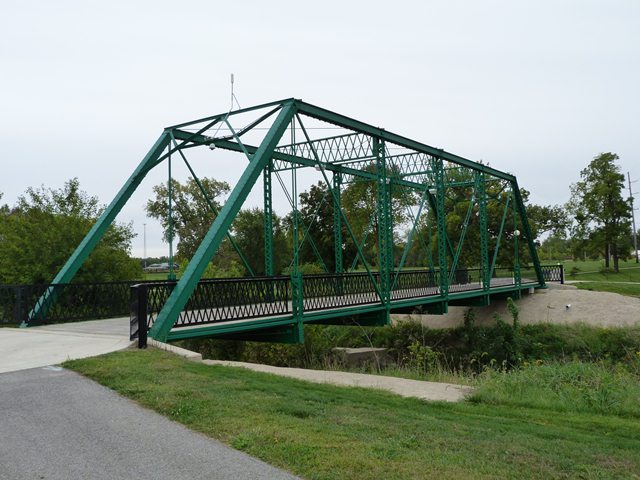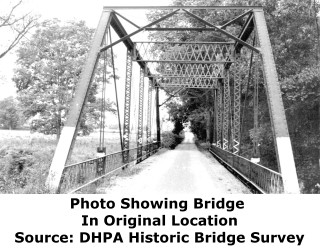We Recommend:
Bach Steel - Experts at historic truss bridge restoration.
BridgeHunter.com Phase 1 is released to the public! - Visit Now
Whitakre Bridge
Jay County Bridge 129

Primary Photographer(s): Nathan Holth and Rick McOmber
Bridge Documented: September 21, 2012
Rural: Jay County, Indiana: United States
1908 By Builder/Contractor: Attica Bridge Company of Attica, Indiana
2006
95.0 Feet (29 Meters)
102.0 Feet (31.1 Meters)
15.7 Feet (4.79 Meters)
1 Main Span(s)
3800123

View Information About HSR Ratings
Bridge Documentation
View Archived National Bridge Inventory Report - Has Additional Details and Evaluation
This is a historic truss bridge that was relocated and preserved for pedestrian use in a park setting. As such, it is an excellent example of the reuse potential that historic metal truss bridges have. View the National Bridge Inventory data sheet for information on this bridge's previous, original location.
The railing on this bridge is not original. It is an attractive lattice design that Indiana has used on multiple historic truss bridge preservation projects. It meets safety requirements, while also looking visually appropriate on the bridge. It is a vast improvement over the cyclone fence and/or wooden railings that look so hideous and out of place on a metal truss bridge. The only complaint with this bridge would be that photos of this bridge in its previous location show original railings on the bridge. Assuming these remained when the bridge was moved, best practice absolutely should have left these in place behind the modern railings. Removing them would serve no purpose and only reduces the historic integrity of the bridge.
This bridge is wired! For whatever reason, an abundance of electrical outlets can be found on this small bridge. Another oddity is that security cameras are conspicuously mounted on either end of this bridge. As near as HistoricBridges.org could tell, this was a quiet park in a pleasant small town, so it is unclear why heavy duty security cameras are needed. On the other hand, if anyone tries to graffiti this bridge there will most certainly be a recording of it.
Information and Findings From DHPA Historic Bridge SurveyStatement of Significance The somewhat heavy verticals and the substantial cross-frames are unusual for such a relatively short span. Otherwise, the trusses are fairly conventionally designed. The bridge retains its original members, including latticed guardrails. Architectural Description Seated upon concrete abutments and wingwalls, this single-span, pin-connected pratt through structure extends 102' in six panels. A pair of moderately heavy, laced channels provides each set of intermediate verticals, and about 3' of laced channels supply the lower portion of the outer verticals, too. A pair of die-forged eyebars serves as the diagonal sets, and single cylindrical rods with turnbuckles counter the diagonals in the two most central panels. The trusses are stabilized by large, latticed cross-frames. The I floor beams are bolted to pin plates. The bridge carries a concrete deck with a 15'4" roadway and 13'6" of vertical clearance. Bridge Considered Historic By Survey: Yes |
![]()
Photo Galleries and Videos: Whitakre Bridge
Bridge Photo-Documentation
Original / Full Size PhotosA collection of overview and detail photos. This gallery offers photos in the highest available resolution and file size in a touch-friendly popup viewer.
Alternatively, Browse Without Using Viewer
![]()
Bridge Photo-Documentation
Mobile Optimized PhotosA collection of overview and detail photos. This gallery features data-friendly, fast-loading photos in a touch-friendly popup viewer.
Alternatively, Browse Without Using Viewer
![]()
Maps and Links: Whitakre Bridge
Coordinates (Latitude, Longitude):
Search For Additional Bridge Listings:
Bridgehunter.com: View listed bridges within 0.5 miles (0.8 kilometers) of this bridge.
Bridgehunter.com: View listed bridges within 10 miles (16 kilometers) of this bridge.
Additional Maps:
Google Streetview (If Available)
GeoHack (Additional Links and Coordinates)
Apple Maps (Via DuckDuckGo Search)
Apple Maps (Apple devices only)
Android: Open Location In Your Map or GPS App
Flickr Gallery (Find Nearby Photos)
Wikimedia Commons (Find Nearby Photos)
Directions Via Sygic For Android
Directions Via Sygic For iOS and Android Dolphin Browser
USGS National Map (United States Only)
Historical USGS Topo Maps (United States Only)
Historic Aerials (United States Only)
CalTopo Maps (United States Only)



